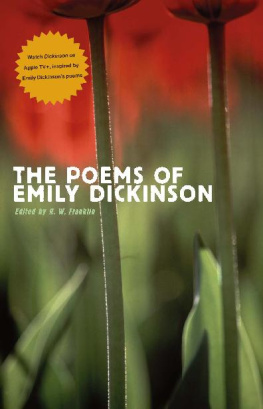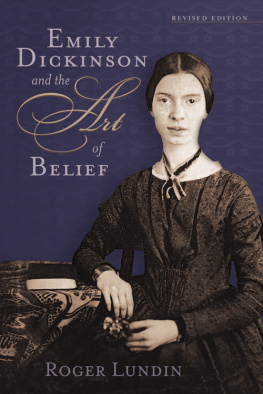Emily Dickinson - The Poems of Emily Dickinson
Here you can read online Emily Dickinson - The Poems of Emily Dickinson full text of the book (entire story) in english for free. Download pdf and epub, get meaning, cover and reviews about this ebook. year: 2005, publisher: Harvard University Press, genre: Art. Description of the work, (preface) as well as reviews are available. Best literature library LitArk.com created for fans of good reading and offers a wide selection of genres:
Romance novel
Science fiction
Adventure
Detective
Science
History
Home and family
Prose
Art
Politics
Computer
Non-fiction
Religion
Business
Children
Humor
Choose a favorite category and find really read worthwhile books. Enjoy immersion in the world of imagination, feel the emotions of the characters or learn something new for yourself, make an fascinating discovery.
- Book:The Poems of Emily Dickinson
- Author:
- Publisher:Harvard University Press
- Genre:
- Year:2005
- Rating:4 / 5
- Favourites:Add to favourites
- Your mark:
- 80
- 1
- 2
- 3
- 4
- 5
The Poems of Emily Dickinson: summary, description and annotation
We offer to read an annotation, description, summary or preface (depends on what the author of the book "The Poems of Emily Dickinson" wrote himself). If you haven't found the necessary information about the book — write in the comments, we will try to find it.
The Poems of Emily Dickinson — read online for free the complete book (whole text) full work
Below is the text of the book, divided by pages. System saving the place of the last page read, allows you to conveniently read the book "The Poems of Emily Dickinson" online for free, without having to search again every time where you left off. Put a bookmark, and you can go to the page where you finished reading at any time.
Font size:
Interval:
Bookmark:
The Poems of Emily Dickinson THE POEMS OF Emily Dickinson READING EDITION  EDITED BY R. W. FRANKLIN The Belknap Press of Harvard University Press Cambridge, Massachusetts, and London, England 1999 Copyright 1998, 1999 by the President and Fellows of Harvard College Copyright, 1951, 1955, 1979 by the President and Fellows of Harvard College Copyright, 1914, 1918, 1919, 1924, 1929, 1930, 1932, 1935, 1937, 1942 by Martha Dickinson Bianchi Copyright, 1952, 1957, 1958, 1963, 1965 by Mary L. Hampson All rights reserved Printed in the United States of America First Harvard University Press paperback edition, 2005 Library of Congress Cataloging-in-Publication Data Dickinson, Emily, 18301886. [Poems] The poems of Emily Dickinson / edited by R. Franklin. Franklin.
EDITED BY R. W. FRANKLIN The Belknap Press of Harvard University Press Cambridge, Massachusetts, and London, England 1999 Copyright 1998, 1999 by the President and Fellows of Harvard College Copyright, 1951, 1955, 1979 by the President and Fellows of Harvard College Copyright, 1914, 1918, 1919, 1924, 1929, 1930, 1932, 1935, 1937, 1942 by Martha Dickinson Bianchi Copyright, 1952, 1957, 1958, 1963, 1965 by Mary L. Hampson All rights reserved Printed in the United States of America First Harvard University Press paperback edition, 2005 Library of Congress Cataloging-in-Publication Data Dickinson, Emily, 18301886. [Poems] The poems of Emily Dickinson / edited by R. Franklin. Franklin.
Reading ed. p. cm. Includes index. ISBN 0-674-67624-6 (cloth) ISBN 0-674-01824-9 (pbk.) I. W. (Ralph William), 1937 . II. Title. Title.
PS1541.A1 1999 811.4DC21 99-11821 Poems by Emily Dickinson in this volume are included
by permission of the President and Fellows of Harvard College
and the Trustees of Amherst College.
She wrote poems every year thereafterin 1877 averring that she had no other Playmatebut the number was never large, fewer than a dozen in some years, usually about twenty or thirty, occasionally more than forty. Although ill in the 1880s, she persevered to the end of life, the art of poetry having become an essential part of her personal expression and communication. The last two poems are from April 1886, incorporated into a letter to her literary friend Thomas Wentworth Higginson, who had already received a good many others. The final lines were a tribute to Helen Hunt Jackson (1685), a celebrated friend from childhood, who had died a few months earlier, as Dickinson, yet unknown, was to do the next. Of Glory not a Beam is left But her Eternal House The Asterisk is for the Dead, The Living, for the Stars Dickinsons workshop in 1860 and in 1865 looked quite different from the mass of manuscripts she left behind at her death. By summer 1860, after two years of work, there were eight fascicles, carefully copied and bound, containing about 170 poems.
This fine array constituted nearly everything in her possession, because she systematically destroyed drafts when she transcribed them to a later form. First came composition in pencil; then a neater copy, also in pencil, which, though it might contain alternative readings still pending, carried forward what she wanted to retain from the initial draft; then the fascicle record in ink, in the early years always a fair copy, all readings resolved. Because of her rules for destruction, the eight fascicles of completed poems were about all she had at hand in mid-1860. This careful order ended in the second half of the year, when Dickinson temporarily stopped making fascicles, and remained in doubt in 1861 and early 1862, a period of apparent personal crisis for her, when fascicle sheets lay unbound for some time and poems were copied in ink individually instead of in groups. Though revived in 1861, her fascicle effort was less comprehensive, with the result that some poems never entered the fascicles or did so only years later. Other copying was divergent, in that individual manuscripts in ink, including a few for poems already in fascicles, appeared anomalously among her papers.
From this time onward, miscellaneous manuscripts, in pencil or in ink, would be present in addition to the little volumes. But the most fundamental change in 1861 was textual: alternative readings, previously confined to the first two manuscript states, were now sometimes brought into the fascicles, a pattern that continued as long as she made them. Dickinson restored order during 1862, perhaps under the steadying attention of Higginson, a new correspondent. She bound up the fascicle sheets remaining from 1861 and, with her muse fully engaged, increased the number of new poems at an extraordinary rate. She composed, copied, and bound relentlessly, so that by early 1864, after two further years of work, she had a total of forty fascicles, containing over eight hundred poems in various states of completion, from fair copies to mere transcriptions of rough worksheets. Besides a somewhat larger pool of miscellaneous manuscripts, which continued to grow that year while she was away for eye treatments, she had a few leftover fascicle sheets.
These odds and ends of her process remained always unbound (such are now called sets). The next year marked an important change, anticipated by those leftover sheets: she ceased binding fascicle sheets entirely, leaving them to their separate ways, even though she made enough to have assembled nine or ten more gatherings. She was energetic, if not quite exhaustive, in reducing the number of preliminary working drafts in her possession by transcribing them into these sets of 1865, which contain poems from as early as 1861, along with others known to have come from 1862, 1863, and 1864. At the end of 1865, about forty miscellaneous manuscripts remained, some of them duplicate, others of ambiguous status. Meanwhile, the number of poems on fascicle sheets, bound or unbound, had reached nearly eleven hundred. Over the last twenty years of her life, as if some form of entropy governed this workshop, she copied few fascicle sheets, stringing them out between 1871 and 1875, with none in 1866-70 or in her last decade.
Most of the poems of these twenty years survive on scraps of discarded household paperincoming letters, abandoned envelopes, advertising flyers, wrapping paperin the second draft or, increasingly, the first. Step by step, she had abandoned the system established in 1858, though the principle of accumulation remained in force, as it had not before 1858. The complex mass of manuscripts found after her death contained forty fascicles, ninety-eight unbound sheets, and seven or eight hundred individual manuscripts, from quite rough to quite finished. Additional manuscripts had been sent to friends and family. Oddly perhaps, none went to her father, mother, or sister, with whom she shared the Homestead, but about 250 poems, by far the largest number, went to Susan Dickinson, her sister-in-law, who lived next door. At greater distance, Higginson received about a hundred, her Norcross cousins, seventy-one, with substantial numbers also going to longtime friends Samuel and Mary Bowles and Elizabeth and Josiah Gilbert Holland.
Next pageFont size:
Interval:
Bookmark:
Similar books «The Poems of Emily Dickinson»
Look at similar books to The Poems of Emily Dickinson. We have selected literature similar in name and meaning in the hope of providing readers with more options to find new, interesting, not yet read works.
Discussion, reviews of the book The Poems of Emily Dickinson and just readers' own opinions. Leave your comments, write what you think about the work, its meaning or the main characters. Specify what exactly you liked and what you didn't like, and why you think so.




